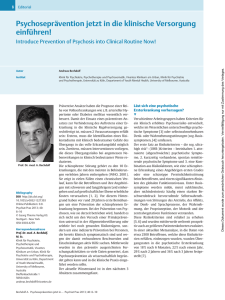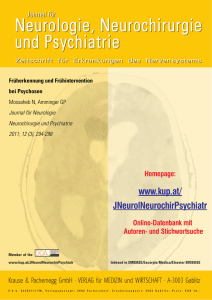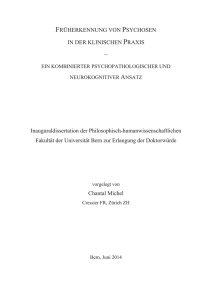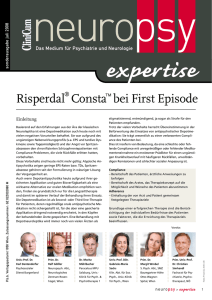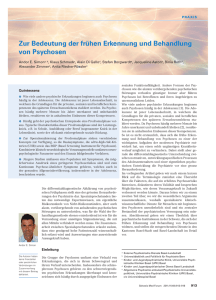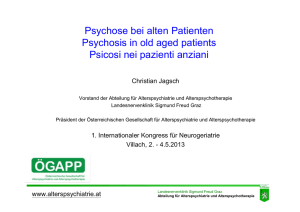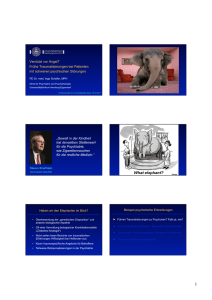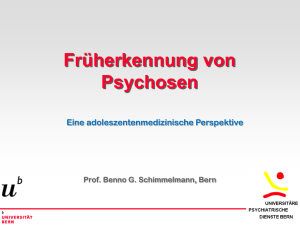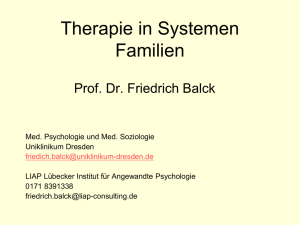Behandlung der Supersensitivitätspsychosen
Werbung
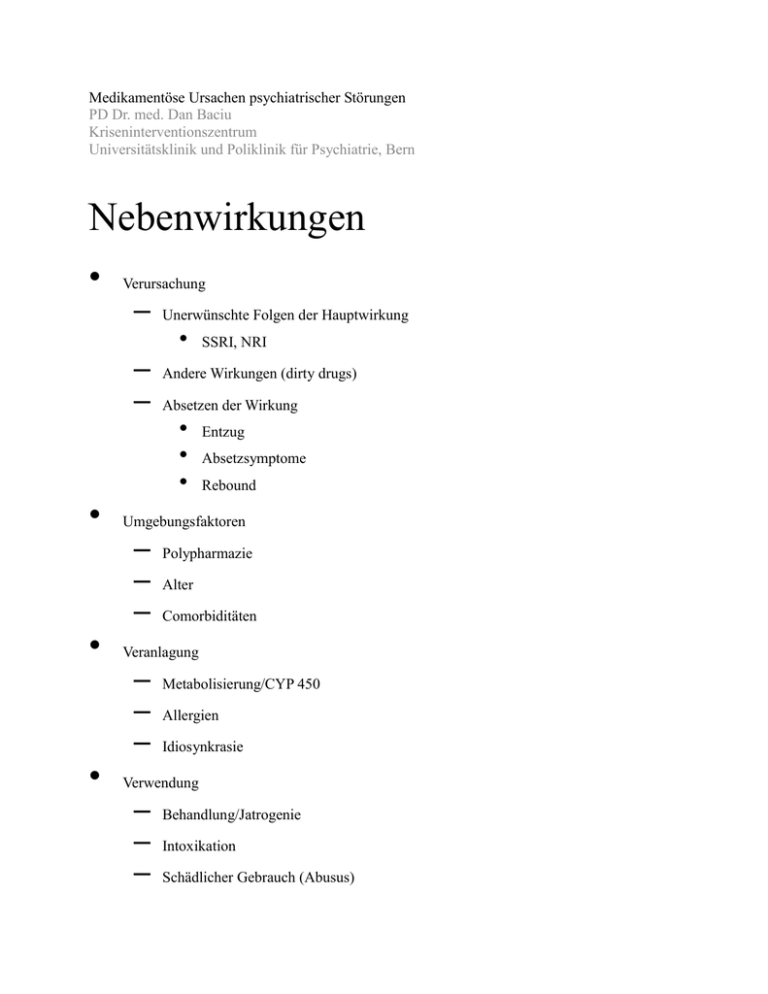
Medikamentöse Ursachen psychiatrischer Störungen PD Dr. med. Dan Baciu Kriseninterventionszentrum Universitätsklinik und Poliklinik für Psychiatrie, Bern Nebenwirkungen • Verursachung – – – • • • Unerwünschte Folgen der Hauptwirkung • SSRI, NRI Andere Wirkungen (dirty drugs) Absetzen der Wirkung • • • Entzug Absetzsymptome Rebound Umgebungsfaktoren – – – Polypharmazie Alter Comorbiditäten Veranlagung – – – Metabolisierung/CYP 450 Allergien Idiosynkrasie Verwendung – – – Behandlung/Jatrogenie Intoxikation Schädlicher Gebrauch (Abusus) Probleme in die Erfassung der medikamentinduzierten psychischen Störungen • • • • • • Delirium • • • • • • • • Viele Medikamente überwinden die Blut-Hirn Schranke psychische NW sind verbreitet und Polymorph Einzelfall Bericht sind die Regel Kaum systematisch kontrollierte Studien Für Zulassungstudien werde alle unerwartete Ereignisse registriert und prozentual angegeben ohne den Zusammenhang zu hinterfragen Die Symptombeschreibung oft ungenügend um ein Delir von einer Psychose zu unterscheiden (Davis 1977) Anticholonergika: Atropin, Antihistaminika: diphenhydramine, etc. Trizyklisch Antidepressiva und Neuroleptika, Atypika, Antiparkinson Medikamente: Levodopa, Amantadin, Biperiden, Bromocriptin Suchtmittel: Alkohol, Sedativa, Hypnotika, Halluzinogene, Cannabis, NO, etc. Gastroenterologika: Cimetidin, Metoclopramid CV: Digitalis, Lidocain, Procainamide, Clonidin, Propranolol, Theophylin, Captopril, • • • • Psychosen • • Narkotika, Analgetika: Ketamin Antibiotika, Tuberkulostatika Contrastmittel: Metrizamid Etc, Etc... Suchtmittel Dopamin – -agonisten: Modafinil, – -präkursoren: Levodopa und – Wiederaufnahmehemmer: -wiederaufnahmehemmer: Bupropion (aber auch Noradrenalin Methylphenidat, Atomoxetin) • • • • • • Glutamaterge: Ketamin, Phenylcyclidine (PCP) Antiinflamatorische Mittel: Indometacin Kortikosteroide CV: Antiarrhytmika, Betablocker, Sympatikomimetika Neuroleptika Antiepileptika Manische Reaktionen • Dopaminagonisten • • • • • • Glutamaterge Antidepressiva Gastrointenstinale: Cimetidin Kortikosteroide MAO Hemmer Benzodiazepine Iatrogenic neurological disorders in old people: a review Kuzuhara S. Nippon Ronen Igakkai Zasshi. 2005 Jan;42(1):21-4 • • • • • • • • Alte Patienten im Japan oft Opfer von Stimulantien oder gefäßerweiternden Medikation – Parkinson, Depression durch flunarizine (Sibelium) und cinnarizin (Stugeron) Reye-like Encephalopathie durch calcium hopantenate. Parkinsonism durch Sulpiride, Tiapride, Metoclopramide oder Atypika dyskinesia induziert durch Antiparkinsonian Medikation oder Antipsychotika Psychotische Symptome durch Antiparkinsonika, und Anticholinergika, Antidepressiva oder Wernicke Encephalopathie durch intravenöse Glukoseinfusion ohne Thiamin Zentral pontine Myelinolyse durch zu schnelle Hyponatriemie Korrektur Creutzfeldt-Jakob Demenz durch Duratransplante, Organe und Blut An auto-iatrogenic disease Reinhart WH. Ther Umsch. 2004 Dec;61(12):715-9. • Medizinische Klinik, Kantonsspital, Chur. [email protected] • • • • • • 55-jähriger Heilpraktiker wohnhaft auf einer nordischen Insel Fühlte Hipersensitivität gegenüber Allergene und Noxen Selbstbehandlung mit Glucokortikoide und Lanzarote Später Umzug in die Schweiz (Graubünden) Dezember 2003 hochpsychotisch, Selbstbehandlung durch Unterkühlung und 250 mg Prednison/die, mehrere Wochen Nekrotische septische Flebitis mit Pseudomonas aeruginosa Sepsis und Exitus Alpha-interferon and mental disorders Debien C, De Chouly De Lenclave MB, Foutrein P, Bailly D. Encephale. 2001 Jul-Aug;27(4):308-17 • • • • • • 30% der Behandelten Patienten: Dosisabhängig, Verabreichungsweg, Co-Medikatin (Chemotherapie) Radiotherapie ddes Schädels Psychiatrische Anamnese Frühsymptome – Müdigkeit, Irritabilität, psychmotorische Verlangsamung, subsyndromale Depression, Anorexie, Libidoverlust, kognitive Störungen, Kopfschmerzen Psychische Störungen – – – – – – 5-15% Depression Selten Suizid Verwirtheit bei co-morbiden Alkoholismus oder HIV Infektionen Manie selten, verschwindet bei Benden der Therapie mit Interferon Angststörungen in form von Phbien oder Zwngsstörungen Athymie durch Hypothiroeose – – Psychosen eher bei Co-Infektionen. (10 Fälle ohne) Oder bei psychiatrische Vorgeschichte nach 3Mnt. Behandlung Behandlung: • • • • • • Psychopharmaka mit reduzierte /keine hepatische Metabolisierung Niedrige Proteinbindung Lange Halbwertszeit Keine aktive Metaboliten SSRI, Milnacipran, Haloperidol, Lithium, Fluvoxamin, Konsequenzen für die Auswahl von Alpha Interpheron und weitere Kombinationsentscheidungen Isoniazid-Induced Psychosis Sacheen Schrestha, M.D., and Adekola Alao, M.D., Dept. of Psychiatry State Univ. of New York, Upstate Syracuse, Psychosomatics 50:640-a-641, November-December 2009 • Report"Ms. B," a 63-year-old white woman with a history of major depressive disorder, developed an acute in the hospital for her psychosis. The dose of quetiapine was titrated to 800 mg daily over the course of a few weeks. The intensity of psychotic symptoms decreased after treatment with quetiapine for 7 days, and Ms. B was discharged home.She continued to receive quetiapine at the same dosage in the outpatient clinic for several weeks. However, she continued to complain of bugs infesting her apartment and crawling under her skin. At this point, we considered the possibility that her psychotic symptoms could have been secondary to INH. Her INH was discontinued, and her symptoms resolved completely after 3 weeks. onset of psychotic symptoms after she was started on prophylactic isoniazid (INH) for a positive tuberculin (purified protein derivative) test. She was also on pyridoxine (25 mg po qd) for prophylaxis against neuropathy associated with INH.Her psychotic symptoms included visual hallucinations of "midgets" coming out of her refrigerator and air-conditioner and in her food, and tactile hallucinations of insects burrowing under her skin. She was eventually hospitalized because of worsening of these symptoms.Initially, INH-induced psychosis was not suspected, and she was treated with quetiapine Weitere Publikationen • Suicidal psychosis secondary to isoniazid. [Pediatr Emerg Care. 2002] Pyridoxine ineffective in isoniazid-induced psychosis.Chan TY. Ann Pharmacother. 1999 Oct; 33(10):1123-4. Isoniazid-induced psychosis.Schrestha S, Alao A. Psychosomatics. 2009 Nov-Dec; 50(6):640-1. Review Isoniazid-associated psychosis: case report and review of the literature. [Ann Pharmacother. 1990]Review Mol Cell Biochem. 2005 Sep;277(1-2):131-5. The effects of isoniazid on hippocampal NMDA receptors: protective role of erdosteine. Cicek E, Sutcu R, Gokalp O, Yilmaz HR, Ozer MK, Uz E, Ozcelik N, Delibas N. • • • • • Isoniazid (INH) hat neurotoxische Wirkungen wie Krampfanfälle, Kognitive Störungen, Hypomnesie, Angst, Depression und Psychose Verursachung durch erhöhtem oxidativen Stress via dem N-methyl D-aspartat Rezeptor(NMDA) Das NMDAR (Ionenkanal gebundener Rezeptor) ist beteiligt an Synaptogenese, synaptische Plastizität, Gedächtnis und Lernen. Mögliche Vorbeungung mit Antioxidativa, z.B. Erdosteine (ein auswurffördernder Wirkstoff/Mucolyticum) Die Autoren haben gezeigt dass Erdostein hat eine schützende Wirkung gegen die oxidativen Effekte der IHN. Praxis (Bern 1994). 2009 Jul 8;98(14):765-6. Acute psychosis caused by co-amoxiclav Bell CL, Watson B, Waring WS.Scottish Poisons Information Bureau, Royal Infirmary of Edinburgh, Edinburgh EH16 4SA. Documed für Augmentin • • Störungen des Nervensystems Gelegentlich: Schwindelgefühl, Kopfschmerzen. • Sehr selten: Reversible Hyperaktivität und klonische Krämpfe. Klonische Krämpfe können bei Patienten mit eingeschränkter Nierenfunktion oder bei Patienten, die hohe Dosen erhalten, auftreten • Erfahrungsberichte (Post-marketing Data)Sehr selten: Erregung, Angst, Schlaflosigkeit, Verwirrung, Verhaltensänderungen, Benommenheit, Dysästhesie. Floxal und Metronidazol Br J Hosp Med (Lond). 2009 Apr;70(4):236-7. Organic psychosis induced by ofloxacin and metronidazole. Koul S, Bhan-Kotwal S, Jenkins HS, Carmaciu CD. A case of multi-drug resistant tuberculosis showing psychiatric adverse effect by cycloserine Fujita J, Sunada K, Hayashi H, Hayashihara K,Saito T. Kekkaku. 2008 Jan;83(1):21-5 • • • • • A 45-year-old man with multi-drug resistant tuberculosis were referred to our hospital for treatment. We started chemotherapy with cycloserine (CS), ethionamide (TH), kanamycin (KM), pyrazinamide (PZA), para-aminosalicylic acid (PAS) and gatifloxacin (GFLX). Two months later, psychosis and seizure occurred and worsened day after day. We suspected that these symptoms were due to CS. After stopping CS, psychosis and seizure disappeared. After surgical operation, positive tubercle bacilli in sputum converted to negative both on smear and culture. He was successfully discharged from our hospital. We should take care on side effects with second-line drugs that are often used in treating multidrug resistant tuberculosis. Ethambutol toxicity manifesting as acute onset psychosis. Martin SJ, Bowden FJ. Int J STD AIDS. 2007 Apr;18(4):287-8. • • Ethambutol is commonly used for the treatment of tuberculous and atypical mycobacterial infection. Central nervous system (CNS) toxicity other than optic neuropathy is not widely reported. • A 40-year-old man with advanced HIV infection and Mycobacterium avium complex infection experienced rapid cognitive decline after commencement of ethambutol, and symptoms fully resolved with cessation. J Clin Psychiatry. 2006 Mar;67(3):492-3. Toxic catatonia secondary to azithromycin. Plana MT, Blanch J, Romero S, Serra M, Gasto C. Serious psychiatric symptoms after chloroquine treatment following experimental malaria infection. Telgt DS, van der Ven AJ, Schimmer B, Droogleever-Fortuyn HA, Sauerwein RW. Ann Pharmacother. 2005 Mar;39(3):551-4 • A 34-year-old healthy woman volunteered to participate in a study of malaria treatment. She was infected on day 0 with a chloroquine-susceptible strain of Plasmodium falciparum and was treated with a standard 3-day course of chloroquine from day 9 onward, following a positive blood smear (parasitemia 0.001%). On day 10, the blood smear became negative. On day 11, she developed a psychotic disorder not otherwise specified, most probably caused by chloroquine use, with symptoms of depersonalization and anxiety. The diagnosis of delirium was considered but ruled out because of clear consciousness with lack of diurnal fluctuations. She refused to take antipsychotic medication. Three weeks later, the woman still encountered serious concentration problems. All complaints gradually subsided over the next 4 months, after which she felt completely recovered. Plasma chloroquine concentrations were within the therapeutic range. DISCUSSION: Chloroquine may achieve high concentrations in the brain and has a long half-life. As quinolines, the antimalarials may have the same pathologic activity as the fluoroquinolone antibiotics in acting as Nmethyl-d-aspartate agonists and gamma-aminobutyric acid antagonists. Application of the Naranjo probability scale indicated that, in this patient, chloroquine was the probable cause of the serious psychiatric symptoms. CONCLUSIONS: Our unique observation demonstrates that serious psychiatric symptoms can emerge as a rare occurrence during standard chloroquine therapy. This adverse effect may persist for several months. Supersensitivität Entzugs/Absetzsyndrome und Supersensitivität Rebound Psychosen • (1) Entzug- und Absetzsyndrome • (2) rebound Syndrome – syndromes (minor and ma- jor new symptoms) [57]; – (rebound Schlafstörungen[58], – rebound Angst[59, 60] und rebound panic [61]), – Beschrieben bei benzodiazepine [62] und selective Serotonin Wiederaufnahmehemmer (SSRIs) [63]; • (3) supersensitivität Syndrome – TD undnd supersensitivität Psychosen[53, 54, 64]. – Die Absetzsyndrome können ein Rückfall in der primären Störung nachahmen Moncrief [65, 66] Literatur • • 53 Chouinard G, Jones BD, Annable L: Neuro- leptic-induced supersensitivity psychosis. Am J Psychiatry 1978;135:1409–1410.54Chouinard G, Jones BD: Neuroleptic-in- duced supersensitivity psychosis: clinical and pharmacologic characteristics. Am J Psychiatry 1980;137:16–21.55 Chouinard G, Annable L, Ross-Chouinard A: Supersensitivity psychosis and tardive dyskinesia: a survey in schizophrenic outpa- tients. Psychopharmacol Bull 1986;22:891– 58 Kales A, Scharf MB, Kales JD: Rebound in- somnia: a new clinical syndrome. Science 1978;201:1039–1041.59 Fontaine R, Chouinard G, Annable L: Re- bound anxiety in anxious patients after abrupt withdrawal of benzodiazepine treat- ment. Am J Psychiatry 1984;141:848–852.60 Chouinard G: Rebound anxiety: incidence and relationship to subjective cognitive im- pairment. J Clin Psychiatry Monogr 1986;4: 12–16.61 Bhanji NH, Chouinard G, Kolivakis T, Mar- golese HC: Persistent tardive rebound panic disorder, rebound anxiety and insomnia fol- lowing paroxetine withdrawal: a review of reboundwithdrawal phenomena. Can J Clin Pharmacol 2006;13:e69–e74.62 Chouinard G: Issues in the clinical use of benzodiazepines: potency, withdrawal, and rebound. J Clin Psychiatry 2004;65(suppl 5):7–12.63 Fava GA, Bernardi M, Tomba E, Rafanelli C: Effects of gradual discontinuation of selec- tive serotonin reuptake inhibitors in panic disorder with agoraphobia. Int J Neuropsy- chopharmacol 2007;10:835–838. Supersensitivitätspsychose • • • 224 Pat (113 Männer und 111 Frauen) mit Schizophrenie Monotherapie mit einem Neuroleptikum + Antiparkinson ohne Antidepressivum oder Phasenprophylaktika oder Benzodiazepine: – 22% Supersensitivitätspschosen [55] Bei höhere Neuroleptika Dosierung, Prolaktinerhöhung und bessere Prognose • • • • • Fazit: Dopamin Hypothese 6 Wochen nach Reduktion oder Absetzen des oralen NL 3 Monate nach Absetzen der Depot Medikatin Anticholinerge Hypothese Supersensitivitätspsychosen sind schwer zu behandeln Literatur • • • • Chouinard G, Annable L, Ross-Chouinard A: Supersensitivity psychosis and tardive dyskinesia: a survey in schizophrenic outpa- tients. Psychopharmacol Bull 1986;22:891– A cross-sectional survey of 224 outpatients (113 men and 111 women) with schizophrenia treated with a stan- dardized single classical antipsychotic treatment (which also included 1 antiparkinsonian, but no antidepressants, no mood stabilizers and no benzodiazepines) showed a prevalence of 22% for supersensitivity psychosis [55] Supersensitivity psychosis was associated with a higher maintenance dose of classical antipsychotics, high prolactin levels and schizophrenia with a ‘good’ progno- sis. The higher antipsychotic dose and higher prolactin levels associated with supersensitivity psychosis lend sup- port to the theory of dopamine supersensitivity and these results suggest that lower doses of antipsychotics could prevent the appearance of supersensitivity psychosis Supersensitivity psychosis, in its masked and with- drawal forms, is known to occur within 6 weeks follow- ing the decrease or withdrawal of an oral antipsychotic or within 3 months for a long-acting injectable antipsychot- ic. We have proposed that TD and supersensitivity psy- chosis can result from the loss of cholinergic interneu- rons in the neostriatum [73] caused by prolonged overac- tivation following antipsychotic-induced elevations in D2 High (D2 receptors with functional high affinity for do- pamine) [74]. The developments of supersensitivity psy- chosis and TD share many characteristics. They can both occur after long-term use of antipsychotics and can become irreversible and difficult to control with readmin- istration of the offending antipsychotic [73] Supersensitivitätspsychosen bei Atypika • • • Schnelles Disozieren vom D2 Rezeptor In der Regel bei Quetiapin und Clozapin[76, 77] und Olanzapin [79]. Zusätzlich die M4 cholinerge agoniste Wirkung welche die Downregulierung der M4R verursacht – Beim Absetzen floride Psychose (77) Behandlung der Supersensitivitätspsychosen • • • • Antiepileptika (Valproinsäuere, Gabapentin und Lamotrigin) Wirksam bei 50% der Patienten mit Supersensitivitäts-psychosen [64, 80]. Wirksam auch bei Supersensitivitätspanik oder –angst durch Absetzen von SSRI (Gabapentin) Auch für Dosisreduktion von SSRI, oder Atypica (Olanzapin) als Strategie zur Reduktion der metabolischen Nebenwirkungen
